Page 147 of 258
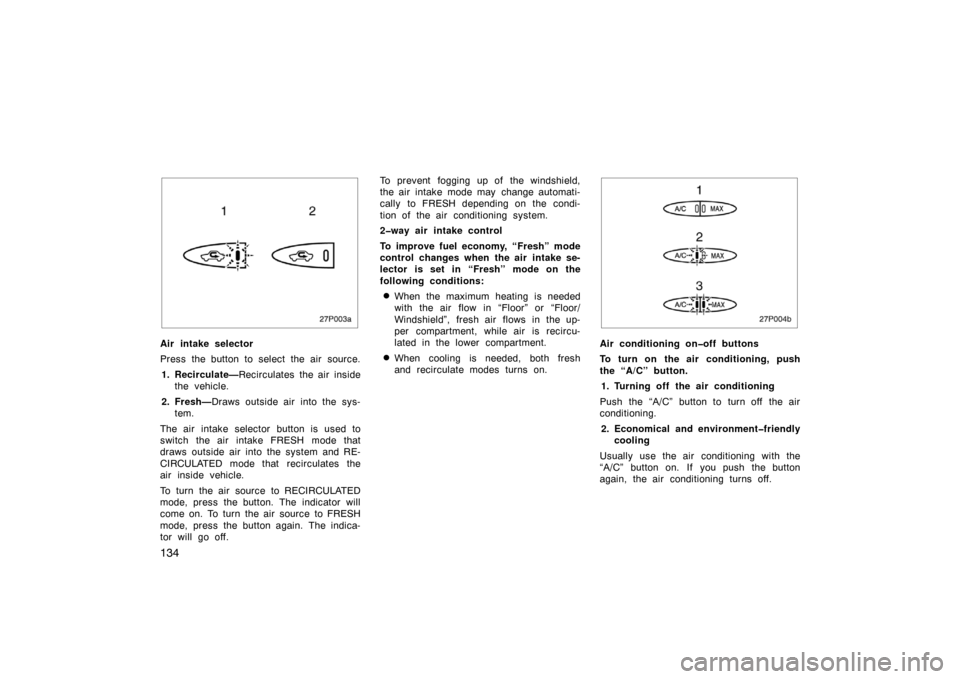
134
27p003a
Air intake selector
Press the button to select the air source.1. Recirculate— Recirculates the air inside
the vehicle.
2. Fresh— Draws outside air into the sys-
tem.
The air intake selector button is used to
switch the air intake FRESH mode that
draws outside air into the system and RE-
CIRCULATED mode that recirculates the
air inside vehicle.
To turn the air source to RECIRCULATED
mode, press the button. The indicator will
come on. To turn the air source to FRESH
mode, press the button again. The indica-
tor will go off. To prevent fogging up of the windshield,
the air intake mode may change automati-
cally to FRESH depending on the condi-
tion of the air conditioning system.
2�way air intake control
To improve fuel economy, “Fresh” mode
control changes when the air intake se-
lector is set in “Fresh” mode on the
following conditions:
�When the maximum heating is needed
with the air flow in “Floor” or “Floor/
Windshield”, fresh air flows in the up-
per compartment, while air is recircu-
lated in the lower compartment.
�When cooling is needed, both fresh
and recirculate modes turns on.
27p004b
Air conditioning on�off buttons
To turn on the air conditioning, push
the “A/C” button.
1. Turning off the air conditioning
Push the “A/C” button to turn off the air
conditioning. 2. Economical and environment�friendly cooling
Usually use the air conditioning with the
“A/C” button on. If you push the button
again, the air conditioning turns off.
Page 148 of 258

135
3. Powerful cooling and dehumidifying
If the air conditioning does not work well
with the “A/C” button on, push the “MAX”
button. To cancel the “MAX” mode, push
the “MAX” button again. To turn off the air
conditioning, push the “A/C” button.
With the “MAX” button on, the gasoline
engine is frequently used.
The air conditioning may not turn on with
the selector lever in “N” position because
the gasoline engine cannot start.
If the “A/C” button indicator flashes, there
is a problem in the air conditioning system
and the air conditioning automatically
shuts off. If this happens, take your ve-
hicle to your Toyota dealer for service. For economical and environment�friend-
ly use
Usually, use the air conditioning with the
“A/C” button on (economical and environ-
ment
−friendly cooling).
In this mode the gasoline engine starts
and stops automatically and good fuel
economy driving is achieved.
To use the air conditioning in economi-
cal and environment�friendly way, we
recommend the following setting: 1. Lower the setting temperature if you feel a little hot with the “A/C” button
on.
2. If you feel still hot with the “A/C” but- ton on, push the “MAX” button also.
After the compartment cools, turn off
the “MAX” mode only.
Page 150 of 258
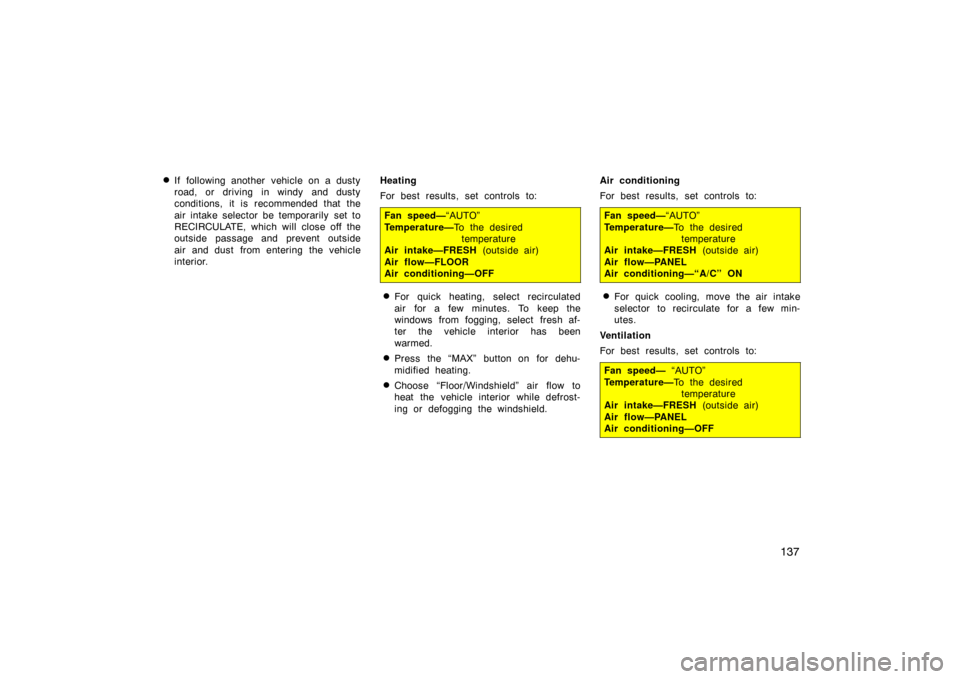
137
�
If following another vehicle on a dusty
road, or driving in windy and dusty
conditions, it is recommended that the
air intake selector be temporarily set to
RECIRCULATE, which will close off the
outside passage and prevent outside
air and dust from entering the vehicle
interior.
Heating
For best results, set controls to:
Fan speed—
“AUTO”
Temperature— To the desired
temperature
Air intake—FRESH (outside air)
Air flow—FLOOR
Air conditioning—OFF
�For quick heating, select recirculated
air for a few minutes. To keep the
windows from fogging, select fresh af-
ter the vehicle interior has been
warmed.
�Press the “MAX” button on for dehu-
midified heating.
�Choose “Floor/Windshield” air flow to
heat the vehicle interior while defrost-
ing or defogging the windshield. Air conditioning
For best results, set controls to:
Fan speed—
“AUTO”
Temperature— To the desired
temperature
Air intake—FRESH (outside air)
Air flow—PANEL
Air conditioning—“A/C” ON
�For quick cooling, move the air intake
selector to recirculate for a few min-
utes.
Ventilation
For best results, set controls to:
Fan speed— “AUTO”
Temperature— To the desired
temperature
Air intake—FRESH (outside air)
Air flow—PANEL
Air conditioning—OFF
Page 151 of 258
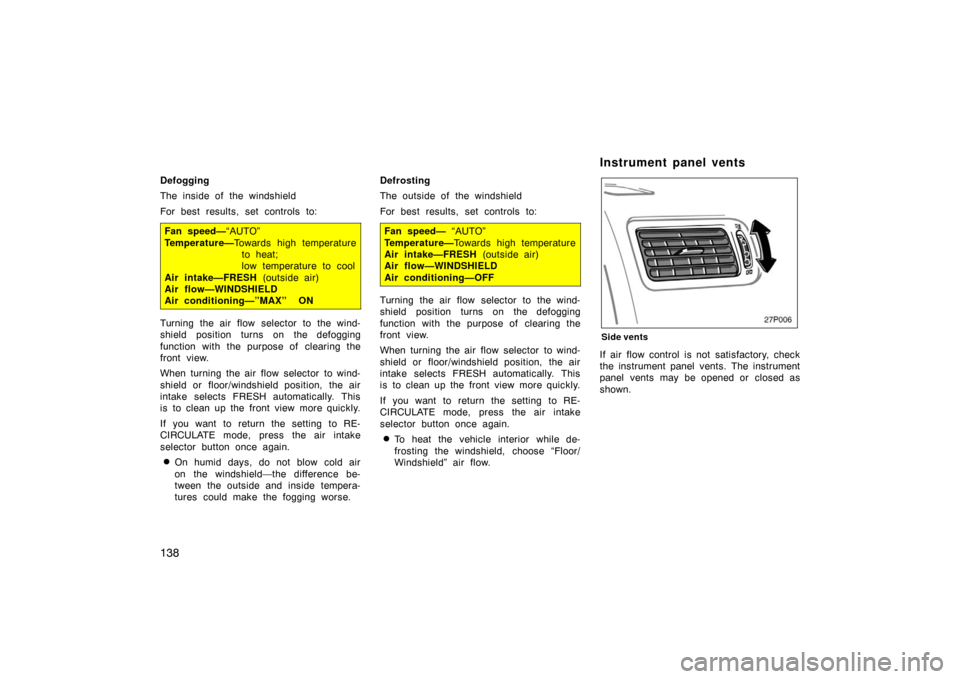
138
Defogging
The inside of the windshield
For best results, set controls to:
Fan speed—“AUTO”
Temperature— Towards high temperature
to heat;
low temperature to cool
Air intake—FRESH (outside air)
Air flow—WINDSHIELD
Air conditioning—”MAX” ON
Turning the air flow selector to the wind-
shield position turns on the defogging
function with the purpose of clearing the
front view.
When turning the air flow selector to wind-
shield or floor/windshield position, the air
intake selects FRESH automatically. This
is to clean up the front view more quickly.
If you want to return the setting to RE-
CIRCULATE mode, press the air intake
selector button once again.
�On humid days, do not blow cold air
on the windshield—the difference be-
tween the outside and inside tempera-
tures could make the fogging worse. Defrosting
The outside of the windshield
For best results, set controls to:
Fan speed—
“AUTO”
Temperature— Towards high temperature
Air intake—FRESH (outside air)
Air flow—WINDSHIELD
Air conditioning—OFF
Turning the air flow selector to the wind-
shield position turns on the defogging
function with the purpose of clearing the
front view.
When turning the air flow selector to wind-
shield or floor/windshield position, the air
intake selects FRESH automatically. This
is to clean up the front view more quickly.
If you want to return the setting to RE-
CIRCULATE mode, press the air intake
selector button once again.
�To heat the vehicle interior while de-
frosting the windshield, choose “Floor/
Windshield” air flow.
27p006
Side vents
If air flow control is not satisfactory, check
the instrument panel vents. The instrument
panel vents may be opened or closed as
shown.
Instrument panel vents
Page 189 of 258
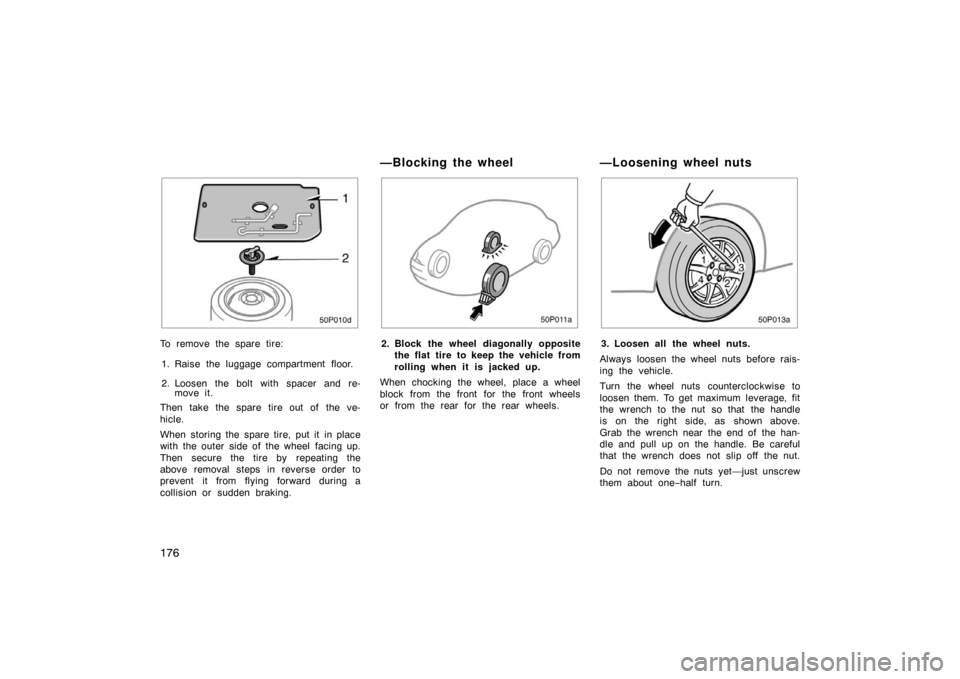
176
50p010d
To remove the spare tire:1. Raise the luggage compartment floor.
2. Loosen the bolt with spacer and re- move it.
Then take the spare tire out of the ve-
hicle.
When storing the spare tire, put it in place
with the outer side of the wheel facing up.
Then secure the tire by repeating the
above removal steps in reverse order to
prevent it from flying forward during a
collision or s udden braking.
50p011a
2. Block the wheel diagonally opposite
the flat tire to keep the vehicle from
rolling when it is j acked up.
When chocking the wheel, place a wheel
block from the front for the front wheels
or from the rear for the rear wheels.
50p013a
3. Loosen all the wheel nuts.
Always loosen the wheel nuts before rais-
ing the vehicle.
Turn the wheel nuts counterclockwise to
loosen them. To get maximum leverage, fit
the wrench to the nut so that the handle
is on the right side, as shown above.
Grab the wrench near the end of the han-
dle and pull up on the handle. Be careful
that the wrench does not slip off the nut.
Do not remove the nuts yet—just unscrew
them about one− half turn.
—Blocking the wheel —Loosening wheel nuts
Page 224 of 258
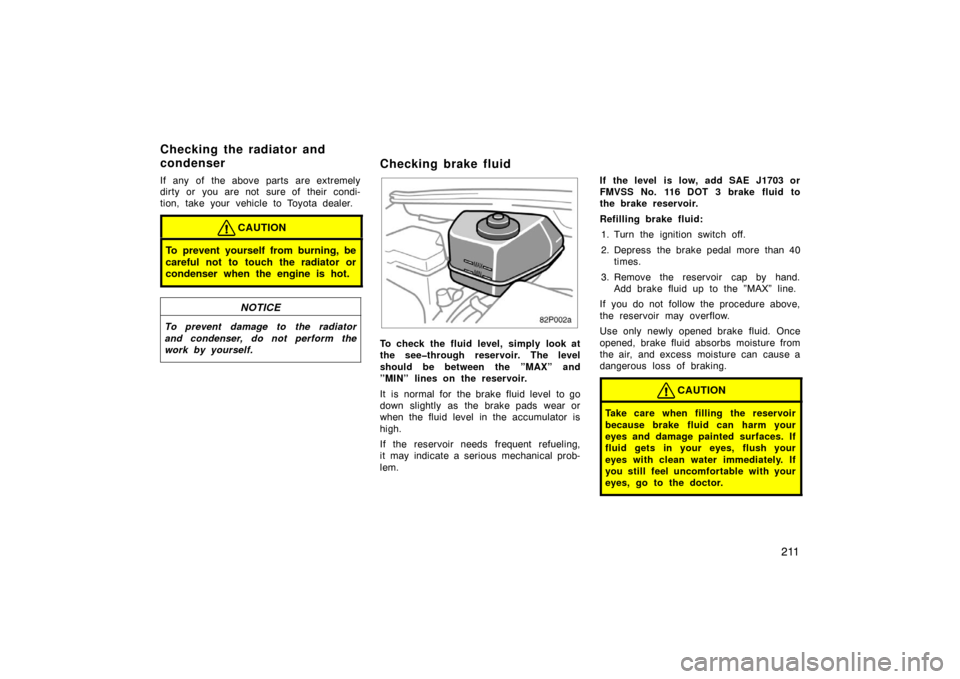
211
If any of the above parts are extremely
dirty or you are not sure of their condi-
tion, take your vehicle to Toyota dealer.
CAUTION
To prevent yourself from burning, be
careful not to touch the radiator or
condenser when the engine is hot.
NOTICE
To prevent damage to the radiator
and condenser, do not perform the
work by yourself.
Checking brake fluid
82p002a
To check the fluid level, simply look at
the see�through reservoir. The level
should be between the ”MAX” and
”MIN” lines on the reservoir.
It is normal for the brake fluid level to go
down slightly as the brake pads wear or
when the fluid level in the accumulator is
high.
If the reservoir needs frequent refueling,
it may indicate a serious mechanical prob-
lem.If the level is low, add SAE J1703 or
FMVSS No. 116 DOT 3 brake fluid to
the brake reservoir.
Refilling brake fluid:
1. Turn the ignition switch off.
2. Depress the brake pedal more than 40 times.
3. Remove the reservoir cap by hand. Add brake fluid up to the ”MAX” line.
If you do not follow the procedure above,
the reservoir may overflow.
Use only newly opened brake fluid. Once
opened, brake fluid absorbs moisture from
the air, and excess moisture can cause a
dangerous loss of braking.
CAUTION
Take care when filling the r eservoir
because brake fluid can harm your
eyes and damage painted surfaces. If
fluid gets in your eyes, flush your
eyes with clean water immediately. If
you still feel uncomfortable with your
eyes, go to the doctor.
Checking the radiator and
condenser
Page 247 of 258
234
Overall length mm (in.) 4305 (169.5)
Overall width mm (in.) 1695 (66.7)
Overall height mm (in.) 1465 (57.6)*
Wheelbase mm (in.) 2550 (100.4)
Front tread mm (in.) 1475 (58.1)
Rear tread mm (in.) 1480 (58.2)
Vehicle capacity weight
(occupants + luggage)kg (lb.) 363 (800)
*: Unladen vehicle
Electric motor
Type: Permanent magnet motor (water cooling)
Rated output: 20 kW
Maximum output: 33.0/1040 − 5600 kW/rpm
Maximum torque: 350.0/0 − 400 N·m/rpm Model: 1NZ
−FXE
Type: 4 −cylinder in line, 4 cycle, gasoline
Bore and stroke, mm (in.): 75.0 x 84.7 (2.95 x 3.33)
Displacement, cm
3 (cu. in.):
1497 (91.4)
Dimensions and weight Engine
Page 249 of 258
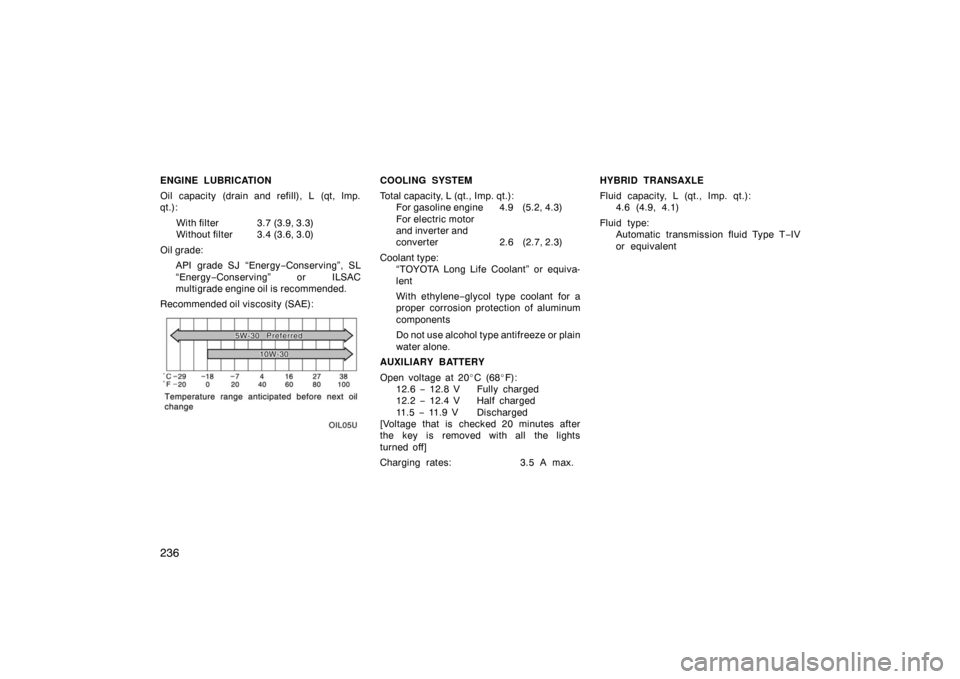
236
ENGINE LUBRICATION
Oil capacity (drain and refill), L (qt, lmp.
qt.):
With filter 3.7 (3.9, 3.3)
Without filter 3.4 (3.6, 3.0)
Oil grade: API grade SJ “Energy −Conserving”, SL
“Energy −Conserving” or ILSAC
multigrade engine oil is recommended.
Recommended oil viscosity (SAE):
oil05u
COOLING SYSTEM
Total capacity, L (qt., Imp. qt.): For gasoline engine 4.9 (5.2, 4.3)
For electric motor
and inverter and
converter 2.6 (2.7, 2.3)
Coolant type: “TOYOTA Long Life Coolant” or equiva-
lent
With ethylene− glycol type coolant for a
proper corrosion protection of aluminum
components
Do not use alcohol type antifreeze or plain
water alone.
AUXILIARY BATTERY
Open voltage at 20 �C (68 �F):
12.6 − 12.8 V Fully charged
12.2 − 12.4 V Half charged
11 . 5 − 11.9 V Discharged
[Voltage that is checked 20 minutes after
the key is removed with all the lights
turned off]
Charging rates: 3.5 A max.HYBRID TRANSAXLE
Fluid capacity, L (qt., Imp. qt.):
4.6 (4.9, 4.1)
Fluid type: Automatic transmission fluid Type T −IV
or equivalent